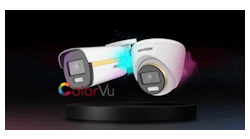Video Surveillance: Analog’s Midlife Crisis
Think fast: Your customer’s DVR has crashed. It’s beyond resuscitation. What do you do?
If you haven’t faced this dilemma already, you are bound to sooner or later, because the average life expectancy of a DVR is about half that of an analog camera. Welcome to the midlife crisis of an analog system.
The stakes keeps mounting. Perhaps the DVR is out of warranty. Maybe the DVR manufacturer is not even in business anymore. What do you do? Before your client rushes to purchase another DVR, consider this: over the course of an analog CCTV system’s life, they will have to replace every single DVR at least once, if not more. It is an expensive proposition without even taking into consideration how much video coverage is lost every time you have to make a swap.
So what’s the alternative? If their analog cameras are still meeting operational requirements — detection, recognition and/or identification — let them keep running, and just replace the DVR with a more future-proof video encoder. It extends the life of your customer’s existing investment and serves as the first step in a clear migration path to a full IP-based solution and all its associated benefits.
As your customer’s analog cameras begin to fail, you can replace them with network cameras which operate seamlessly with their encoder counterparts. It is a great strategy for upgrading in affordable increments — after all, not everyone has the financial resources to buy a high-performance Porsche halfway through their life.
DVRs vs. Encoders
Nowhere is the advantage of open standards more clear than in the contrast between DVR and encoder technology. Here are five of the major differences:
1. Cost of expansion: Face it, the DVR is the most expensive, proprietary PC that your customer will ever buy. They are often forced to purchase spare parts such as additional storage from the manufacturer when the same components could be purchased for half the price on the open market.
A video encoder is an open-platform technology that acts as a bridge between the analog and digital world by essentially turning an analog investment into IP cameras. Because it conforms to open standards, the encoder enables customers to expand their systems with virtually unlimited retention capacity using off-the-shelf computer hardware, which can be a huge cost savings. Nowadays many encoders support SD cards for onboard storage which can provide smaller installations with enough storage to replace the DVR itself or deliver redundancy to larger enterprise installations.
2. Scalability: DVRs do not leave much room for growth. They ship in fixed increments — four, eight or 16 channels; and they typically come pre-configured with storage ranging from one to four terabytes with few options for expanding beyond the default configuration. These limitations might restrict customers from deploying proper camera coverage, since it can be very expensive to incrementally add additional cameras beyond the fixed number of channels.
Video encoders, on the other hand, are available in one-channel versions that can be placed close to the analog camera, or in multi-channel versions with up to 84 channels per chassis. Thus, customers can add channels in any increment they need, creating a more cost-efficient mechanism for future expansion of their surveillance system. Once the head-end has been migrated to IP, new network cameras can be added to the system one- or many-at-a-time wherever an Ethernet drop is available or using the very same coax cable that analog cameras do, with the addition of a Ethernet to Coax converter.
Some encoders support control of PTZ cameras using the coax cable, which limits the amount of cabling needed in an installation. SFP (small form-factor pluggable) fiber slots make it easier to integrate certain encoders into newer fiber-based network infrastructures. This is commonly the case in large retail stores or warehouses where the distances between MDF closets might be long.
3. Performance: DVRs use a cookie-cutter approach to surveillance. Designed to meet 80 percent of the market needs, they offer a limited number of frames per second that can be recorded across all channels; thus, they commonly stream video at 7.5 or 15 frames-per-second (fps) per channel.
The latest encoders support up to 60 fps, which delivers smooth video even in high-motion scenes. They exceed the operational requirements of analog cameras and a DVR by reducing noise and increasing image sharpness and contrast. This enables users to record and view higher quality video at higher frame rates to increase their situational awareness.
4. Single point of failure: If the DVR fails, the whole CCTV system fails — and then the system is down for however long it takes to fix or replace the DVR. That increases the customer’s risk. Encoders, on the other hand, offer a number of redundancy options to keep the surveillance system up and running. For example, you can power one- or four-channel encoders via Power over Ethernet and tie them into the UPS system in the server room. Some encoders have dual power supplies built in. Some have a blade system where the channels can be hot swapped if a blade fails. Some encoder rack solutions have redundant network ports. Some have all of the above.
5. Intelligence: In an analog system, intelligence needs to be performed by the DVR along with all the other tasks such as compression and storage. With a closed platform, the customer often can only select from the limited intelligence applications available from that specific DVR vendor. Video encoders, however, can support third-party intelligent applications running inside the encoder, which gives users the flexibility to build a best-of-breed solution with sufficient computing performance for every video channel. Digitizing the video signal also allows the customer to select much more intelligent video management software from any leading global provider.
Taking all of this into consideration, it is clear that swapping video encoders for end-of-life DVRs provides significant advantages in terms of scalability, performance and redundancy. Encoders also provide security practitioners with the tools needed to improve image usability, situational awareness and, ultimately, increase the overall security posture of an organization.
A Major Sales Opportunity
According to the global research firm IHS Inc., in 2014 new sales of IP video will account for 50 percent of the revenue in the video surveillance market. While this indicates that the battle for supremacy is starting to tip in favor of IP technology, it is important to recognize the flip side of the coin: Of the more than 50 million video cameras currently installed around the world today, more than 80 percent of them are still analog.
For the sake of argument, let’s say that a majority of them are attached to 16-channel DVRs. That means there are more than 2.5 million DVRs currently aging across the globe that could be candidates for replacement. That is a huge market opportunity for video encoders, and one that would be foolish to ignore.
Replacing failed DVRs with video encoders gets your foot in the door and can be your first step towards building a long-term customer relationship. As a bridging technology, encoders help your customer extend the value of their existing analog cameras. Then, as that legacy technology begins to age out, you will have already laid the foundation to help them gradually migrate to a full IP solution and reap all the accompanying benefits.
James Marcella has been a technologist in the security and IT industries for nearly two decades. He is currently the Director of Technical Services for Axis Communications. To request more info about Axis, please visit www.securityinfowatch.com/10212966.




